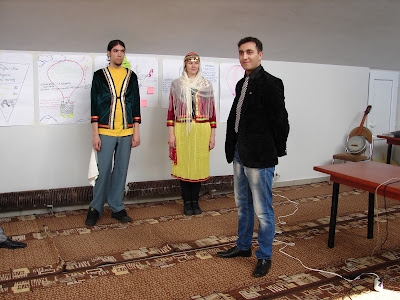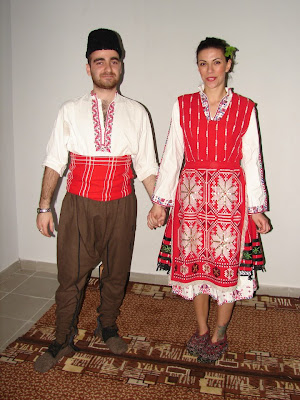Latvian group presented us their pre-christian gods and the symbols which represent each one of them.
Pērkons-Thunder
This symbol is also called thunder cross, fire cross, branch cross or svastika. Thunder cross or fire cross symbolizes and attracts happiness, energy, fire, wind and thunder.
Thunder is the deity who hunts evil forces.
Saule-Sun
Sun is the eternal symbol of life and movement. She knows and sees everything. In front of other signs sun occupies a place of honour, because she is considered as mother of all children. She also teaches justice and mercy.
Mēness- Moon
The job of the Moon is to take care about stars as father to his children. He is not as lovely as mother sun, but still owns a lot of respect.
This symbol is known as the best for farmers. They knew that he influences and contributes to growth of corn. Moon is also considered as warrior protector.
Zvaigznes - Stars
They protect from Evil. AUSEKLIS is kind of morning star which symbolizes victory of life.
Dievs- God
God is creator and advisor. He is happy, beautiful, beneficial. He rules and decides. He is a fellow traveller. He is wise and kind of mentor.
Laima
Sometimes she is a member of a triad of fate deities with Karta and Dekla. Sometimes they are three goddesses, sometimes they are a triple goddesses and sometimes only Laima is mentioned.
Laima rules over unchangable fate, but she also cares about the people who fates she sets and help them.
Māra
Mara is the highest-ranking goddess in Latvian mithology, a femenine God. She is the patroness of al femenine deities.
Ūsiņš
God of light and spring, symbol of fertility, guardian of houses and bees.
Jumis
Jumis is the Latvian god of field and fertility. His symbol-two corn stalks or any other fruit which have grown together, symbolizes wealth. It means that he gives everything double.
martes, 16 de abril de 2013
Latvian pagan deities
lunes, 15 de abril de 2013
Yezidi representatives visited our Youth Exchange
Two representatives of Yezidi community living in Armenia visited us. The vice-president of the organization "Yezidi National Union", Khdr Hajoyan, shared their unknown beliefs and traditions. They talked about Melek Taus, the holy pickock that the worship, who has been identified like Satan in other cultures, trying to make people think that Yezidis are a Satanic sect, just to discredit this religion. This believe is not true because Yezedis doesn´t have the concept of Satan that other religions created. Furthermor, they don´t believe in the notion of bad. They explained us how their three casts works in issues like weddings, forbidden between two people who belongs to different casts.
After the presentation, Khdr Hajoyan played and sang traditional Yezedi songs and they pretended a yezedi traditional wedding between two of our Slovenian participants.
We will keep on knowing Yezidi culture, this time, from inside: they invited us to their New Year cellebration, which will take place this week in an Armenian cementery.
After the presentation, Khdr Hajoyan played and sang traditional Yezedi songs and they pretended a yezedi traditional wedding between two of our Slovenian participants.
We will keep on knowing Yezidi culture, this time, from inside: they invited us to their New Year cellebration, which will take place this week in an Armenian cementery.
Armenian pagan deities
Armenian group presented some topics about paganism in Armenia, like the main gods that Armenians worshipped.
Armenian mithology was influenced by Zoroastrianism and Assyrian traditions. At first, Armenians worshipped fire, sun, water and holy animals like lions, but relations with other countries made them begin to worship some gods. Some of these gods were identified with hellenistic gods.
Aramazd
God-Sun. The father of all the gods and creator of the Universe. Aramazd was supposed to born on 21th of March, according to the current calendar. Some neo-pagans in Armenia still cellebrate this feast.
Anahit
Anahit was the god of fertility and birth. It´s not clear yet if she was the wife or the daughter of Aramazd. Navasard, still celebrated in August, is the feast dedicated to Anahit. Identified with Aphrodite.
Mihr
The God of light and Sun. The pagan temple of Garni was built to worship him.
Vahagn
God of thuder and lightning. He was a God of war aswell. Identified with Heracles.
Astghik
God of love, beauty and water. Lover of Vahagn. Her feast, Vartavar, is still celebrated with water fights. It´s said that the day of this feast is the hottest day of the year in Armenia.
Armenian mithology was influenced by Zoroastrianism and Assyrian traditions. At first, Armenians worshipped fire, sun, water and holy animals like lions, but relations with other countries made them begin to worship some gods. Some of these gods were identified with hellenistic gods.
Aramazd
God-Sun. The father of all the gods and creator of the Universe. Aramazd was supposed to born on 21th of March, according to the current calendar. Some neo-pagans in Armenia still cellebrate this feast.
Anahit
Anahit was the god of fertility and birth. It´s not clear yet if she was the wife or the daughter of Aramazd. Navasard, still celebrated in August, is the feast dedicated to Anahit. Identified with Aphrodite.
Mihr
The God of light and Sun. The pagan temple of Garni was built to worship him.
Vahagn
God of thuder and lightning. He was a God of war aswell. Identified with Heracles.
Astghik
God of love, beauty and water. Lover of Vahagn. Her feast, Vartavar, is still celebrated with water fights. It´s said that the day of this feast is the hottest day of the year in Armenia.
sábado, 13 de abril de 2013
Eslovenian cultural evening
Bulgarian cultural evening
Pagan slavic gods in Ucrainian territory
The Ukranian group presented us some slavic gods who were worshipped in Ucrainian territory during the pagan times.
The origin of the word "pagan" is still not clear. Most likely, this word is associated with the word "tongue" or "language", hence its value -the tribe, the people who speak the same language. From etymological dictionary of the Ukrainian language, the word "pagan" is "a tribe of people bound by common custom and origin".
Rod
Creator of the Universe, God of Gods.
Perun
Lightning, thunter, was the god of king´s army. All of the myths of Perun, preserved in Ukraine depict him like a shooter.
Yarilo
God of fertility and fecundity.
Veles
Protector of cattle and poetry.
Svarog
God-smith, taught people marriage, agriculture and gave them the plow.
Hors
God of Sun
Lada
One of the oldest pagan gods, the goddesh of harmony in nature, love in marriage, mother-nurse of Peace.
Mokosh
Probably the mother goddesh, the goddesh of earth, fertility and weaving.
Rozhanitsy
Goddesh of fate.
Stribog
God of wind
The origin of the word "pagan" is still not clear. Most likely, this word is associated with the word "tongue" or "language", hence its value -the tribe, the people who speak the same language. From etymological dictionary of the Ukrainian language, the word "pagan" is "a tribe of people bound by common custom and origin".
Rod
Creator of the Universe, God of Gods.
Perun
Lightning, thunter, was the god of king´s army. All of the myths of Perun, preserved in Ukraine depict him like a shooter.
Yarilo
God of fertility and fecundity.
Veles
Protector of cattle and poetry.
Svarog
God-smith, taught people marriage, agriculture and gave them the plow.
Hors
God of Sun
Lada
One of the oldest pagan gods, the goddesh of harmony in nature, love in marriage, mother-nurse of Peace.
Mokosh
Probably the mother goddesh, the goddesh of earth, fertility and weaving.
Rozhanitsy
Goddesh of fate.
Stribog
God of wind
Etiquetas:
Paganism,
Slavic gods,
UKraine
lunes, 8 de abril de 2013
Suscribirse a:
Comentarios (Atom)






































